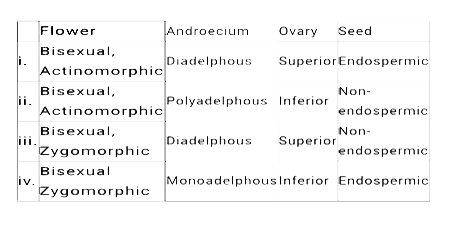Describe the distinguishing characters of family Fabaceae.
Step-by-Step Solution:
1. Root Structure:
- The Fabaceae family has dicot roots, which means they possess two cotyledons.
- They exhibit a tap root system, characterized by one main root with branching roots.
- Notably, root nodules are present, which house nitrogen-fixing bacteria that convert atmospheric nitrogen into a usable form for the plant.
2. Stem Characteristics:
- The stems in the Fabaceae family can be erect or climbing.
- Some species have stems that are modified for climbing, allowing them to grow vertically or attach to supports.
3. Plant Form:
- This family includes a variety of forms, primarily shrubs and herbs, which contribute to its diversity.
4. Inflorescence Type:
- The inflorescence in Fabaceae is typically racemose, meaning that flowers are arranged along a central stem with lateral branches that continue to produce flowers.
5. Flower Structure:
- Flowers in the Fabaceae family are bisexual, containing both male (stamens) and female (pistil) reproductive organs.
- They exhibit zygomorphic symmetry, also known as bilateral symmetry, allowing them to be divided into symmetrical halves along one plane.
6. Estivation of Floral Parts:
- The arrangement of sepals and petals (estivation) can be either valvate or imbricate.
- Valvate estivation means the edges of the petals and sepals touch without overlapping, while imbricate means that they overlap in a specific pattern.
7. Corolla Estivation:
- The corolla (the collective term for the petals) also shows vexillary or imbricate estivation, indicating a specific arrangement of petals that is characteristic of this family.
8. Notable Members:
- The Fabaceae family includes significant members such as the genus *Lathyrus*, which is commonly known as the pea family.
- The Fabaceae family has dicot roots, which means they possess two cotyledons.
- They exhibit a tap root system, characterized by one main root with branching roots.
- Notably, root nodules are present, which house nitrogen-fixing bacteria that convert atmospheric nitrogen into a usable form for the plant.
- The stems in the Fabaceae family can be erect or climbing.
- Some species have stems that are modified for climbing, allowing them to grow vertically or attach to supports.
- This family includes a variety of forms, primarily shrubs and herbs, which contribute to its diversity.
- The inflorescence in Fabaceae is typically racemose, meaning that flowers are arranged along a central stem with lateral branches that continue to produce flowers.
- Flowers in the Fabaceae family are bisexual, containing both male (stamens) and female (pistil) reproductive organs.
- They exhibit zygomorphic symmetry, also known as bilateral symmetry, allowing them to be divided into symmetrical halves along one plane.
- The arrangement of sepals and petals (estivation) can be either valvate or imbricate.
- Valvate estivation means the edges of the petals and sepals touch without overlapping, while imbricate means that they overlap in a specific pattern.
- The corolla (the collective term for the petals) also shows vexillary or imbricate estivation, indicating a specific arrangement of petals that is characteristic of this family.
- The Fabaceae family includes significant members such as the genus *Lathyrus*, which is commonly known as the pea family.
Topper's Solved these Questions
- MORPHOLOGY OF FLOWERING PLANTS BOOK - MODERN PUBLICATIONCHAPTER - MORPHOLOGY OF FLOWERING PLANTS EXERCISE - HIGHER ORDER THINKING SKILL (LONG ANSWER QUESTIONS )
6 Videos
- MORPHOLOGY OF FLOWERING PLANTS BOOK - MODERN PUBLICATIONCHAPTER - MORPHOLOGY OF FLOWERING PLANTS EXERCISE - QUICK MEMORY TEST ( SAY TRUE OR FALSE )
26 Videos
- MORPHOLOGY OF FLOWERING PLANTS BOOK - MODERN PUBLICATIONCHAPTER - MORPHOLOGY OF FLOWERING PLANTS EXERCISE - HIGHER ORDER THINKING SKILL ( VERY SHORT ANSWER QUESTIONS )
9 Videos
- MINERAL NUTRITION BOOK - MODERN PUBLICATIONCHAPTER - MINERAL NUTRITION EXERCISE - CHAPTER PRACTICE TEST
16 Videos
- NEURAL CONTROL AND COORDINATIONBOOK - MODERN PUBLICATIONCHAPTER - NEURAL CONTROL AND COORDINATIONEXERCISE - Chapter Practice Test
11 Videos
Similar Questions
Knowledge Check
Which of the following describes the characters of the family Fabaceae?
Apinnately compound leaf, zygomorphic flower, racemoseBreticulate venation, zygomorphic, cymoseCestipulate, actinomorphic, synandrousDalternate leaves, bisexual, bicarpellary
Describe some distinguishing features of mosses.
View SolutionGive an account of the distinguishing features of family Solanaceae. Give botanical names of four plants of economic value belonging to this family.
View Solutionfamily brassicaceae, distinguishing features OF families fabaceae,solanaceae, liliaceae and brassicaceae
View SolutionWhat are the distinguishing characters of kingdom fungi?
View SolutionDescribe the distinguishing features of the phylum Platyhelminthes or Aschelminthes.
View SolutionChoose the option which accurately represents the characteristics of family Fabaceae .

View SolutionWrite four distinguishing characters of phylum - Echinodermata.
View Solution
